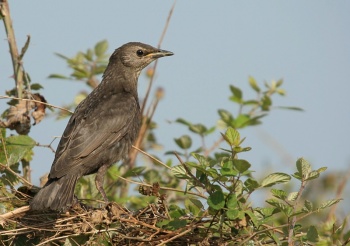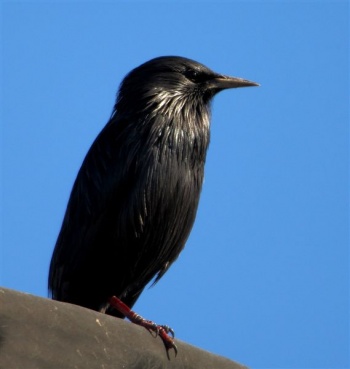- Sturnus unicolor
Alternative name: Mediterranean Starling
Identification
22cm. A medium-sized starling
- Unspotted 'oily'-looking black plumage in spring and summer with purple or green gloss (depending on angle of light)
- Some tiny pale spots on flanks and mantle in winter and in females
- Greatly elongated feathers of crown, nape, throat and upper breast
- Short-looking bill, yellow with bluish-black base in summer, blackish outside breeding season
- Pink or reddish-pink legs, duller outside breeding season
- Juveniles are dull brown; distinctly darker than juvenile Common Starlings
Similar species
Common Starling can be almost devoid of spots, but there is still a structural difference, particularly in the throat feathers (long and slender in Spotless, short in Common). Spotless Starlings are always blacker than Common Starlings.
Distribution
Found in the western Mediterranean in Portugal, Spain, extreme southernmost France, Corsica, Sardinia, Sicily and northwest Africa (Morocco, Algeria and Tunisia). Vagrants have been recorded as far north as Denmark.
Common to abundant in its range.
Taxonomy
This is a monotypic species[1].
Has been treated as conspecific with Common Starling, and hybrids are common where the two species overlap in northeast Spain.
Habitat
Open grassy areas and areas of human habitation from towns to farm buildings. In overlap zone with Common Starling, prefers warmer, drier, more open, lowland areas.
Behaviour
Diet
Omnivorous, feeds on invertebrates, fruits, seeds and scraps.
Forms large feeding flocks.
Breeding
Breeding season from March to July, breeds often twice a year. A colonial nester. They nest in holes in buildings or trees and cliff crevices. Nesting also recorded in old holes of European Bee-eater or Sand Martin. The clutch averages 4 eggs.
References
- Clements, JF. 2009. The Clements Checklist of Birds of the World. 6th ed., with updates to December 2009. Ithaca: Cornell Univ. Press. ISBN 978-0801445019.
- Del Hoyo, J, A Elliott, and D Christie, eds. 2009. Handbook of the Birds of the World. Volume 14: Bush-shrikes to Old World Sparrows. Barcelona: Lynx Edicions. ISBN 978-8496553507
Recommended Citation
- BirdForum Opus contributors. (2025) Spotless Starling. In: BirdForum, the forum for wild birds and birding. Retrieved 28 April 2025 from https://www.birdforum.net/opus/Spotless_Starling
External Links
Search the Gallery using the scientific name:
Search the Gallery using the common name:
GSearch checked for 2020 platform.






